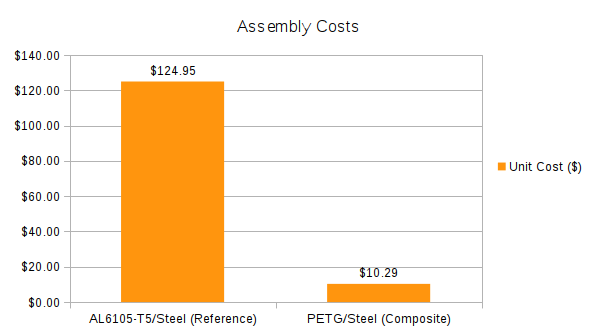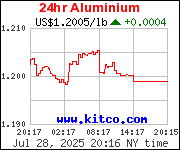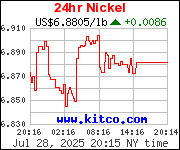You are here
Recyclable Thermoplastic Component Integration

ABSTRACT: Allied Metal Group completes study of new mechanical components fabricated from recyclable petrochemical and plant-based plastics, develops new thermoplastic composite assemblies from them that are lighter and cheaper for use in future production. Resulting thermoplastic assemblies prospectively more environmentally friendly and yield more reusable petroleum-based end-product.
Conditions
The study considered two categories of static mechanical assemblies, a reference composed entirely of metal and a composite composed of metal combined with plastic.
The reference design is a derivative of an existing mass-produced all-metal assembly composed principally of T-6000 family aluminum alloys. New designs, adapted from the reference design but manufactured by filament deposition modeling processes incorporating non-metal components, to any degree, constituted the composite assembly category. All assemblies were designed for use in operating environments defined by the range considered in OSHA Standard Number 1910.100041.
Conclusions drawn by this study focus on the largest case considered by it which is that of a 20.74 cubic inch mechanical assembly. The reference design of the largest test case involved an existing mass-produced all-metal assembly composed largely of a T-6000 family aluminum alloy with small quantities of 1040 alloy carbon steel use in subcomponents. The composite design of the largest test case was a design comparable to that of the reference in overall dimensions and geometry, differing principally in material composition.
Assembly designs were confined to those in which mechanical or other design impositions required assemblies of equal overall dimensions and usable volume, thus dismissing cases in which assemblies of dissimilar size could be treated as functionally equivalent, as by virtue of advantages in either tensile or compressive strength or the isotropic nature of the metals employed that would permit dimensional reductions, relative to their composite counterparts, among the reference designs. All assemblies tested by this study were limited to a volume of approximately 21 cubic inches (that of the largest case). Polylactic-acid (PLA) and polyethylene terephthalate glycol (PETG), two commonly recycled thermoplastics, where ultimately selected as substitutes for metal in the test assemblies with PETG selected for use in final designs of the composite assembly category. Composite designs were considered suitable for testing when they fulfilled the volumetric and load criteria common to the reference. In all cases, neither reference or composite designs were subjected to loads approaching their structural limits as the tests were not concerned with ultimate assembly strength but with bulk material substitution in low-load environments, thus the tests can be considered of practical use in applications involving only moderate loads imposed far from the assemblies' ultimate design limits.
Observations
Differing material compositions and densities among the reference and composite assemblies resulted in expected differences in weight between corresponding samples. A net reduction in weight of approximately 31% was achieved with the final composite assembly design.

The composite assembly's reduced weight corresponded to the reduction of metal used in its composition, with total reduction of over 91% by volume and over 64% by weight.

Differences in cost were notable among observations arising from the study. As tested, the composite assembly cost was reduced by a factor of 12 from that of the reference assembly. Because the reference assembly exists in a readily available mass-produced form, overhead costs of extrusion die construction, production minimums imposed by bulk fabricators that would make single-unit production costs artificially high, and actual cost of fabrication, have been ignored. Likewise, costs of computer modeling and engineering necessary to manufacture both reference and composite assemblies are considered as roughly comparable, therefore negating one another, and, consequently, ignored. Another aspect of cost, that of assembly modification, is not considered here but can be assumed as favoring the composite assembly design given the fabrication processes required to substantially alter the materials of the reference assembly, such as machining with skilled labor and/or CNC apparatuses, are costlier than the largely autonomous filament deposition process used to alter, or reproduce most of, the composite assembly.

Environmental
Environmental factors were also given consideration by this study. All the materials incorporated into the reference and composite assemblies are recyclable. Building trades and designers whose projects are subject to environmental design standards such as LEED might consider both reference and composite assemblies as capable of fulfilling certain aspects of those standards. However, from environmental and economic standpoints, the composite assemblies pose certain advantages. The temperatures required to induce the phase change necessary for recycling of aluminum and steel occur at approximately 603 °C and 1370 °C, respectively, are more than a factor of 10 greater than those necessary for the analogous glass transition phase that occurs between only 61 °C and 87 °C for typical formulations of PETG. The comparatively low glass transition phase of PETG permits recycling at smaller scales using less energy whereas recycling of metals such as aluminum and steel typically occur in bulk through more sophisticated minimills. Even when ignoring the scale and type of recycling processes, the energy costs of recycling are far higher, at any quantity, for constituent materials of the reference assembly than those of the composite.
As a petrochemical, PETG relies on a finite resource, attention to the stewardship of which is likely to increase as crude oil reserves diminish. Proposing the further use of plastics, and of PETG in the particular case of composite assembly manufacturing, may seem counter to conservation efforts, yet it can be shown crude oil consumption for plastic production is comparatively low relative to its other uses. In 2006, approximately 4% of global crude oil production was used to manufacture all types of plastics globally2 with an additional estimated 4% used to power the production process4. During the same period, <0.5% of global crude oil production was used to manufacture PET3 (polyethylene terephthalate, the principal constituent of PETG).
While net petroleum consumption is higher for the production of all petrochemical plastics than those for either aluminum or steel individually, it remains lower than the combined amount used to produce both metals necessary to replicate the assemblies considered by this study, and is lower still when considering PETG alone. However, a distinction in petroleum consumption of broader applicability than the cases of this study remains in the distribution of petroleum used in the manufacturing processes of the metals and petrochemical plastics in this study. For aluminum and steel, energy to power their respective manufacturing processes represents total petroleum consumption whereas only half of petroleum consumption is used for energy in the case of petrochemical plastics, the implication being that petroleum utilized to produce aluminum and steel is expended entirely, making it inaccessible, whereas the balance of petroleum consumption is reclaimable for petrochemical plastics by virtue of the end product's recyclability.
As noted, this study concerns static mechanical assemblies. Although outside the scope of this study, were these assemblies intended to be kept in motion, the reduced mass of the composite assembly may confer to it an advantage when the energy required to initiate or arrest its motion are considered, assuming the assembly's application permits a reduction in its mass.
Limitations
Life cycle costs are not considered by this study. Although the material compositions of both the reference and composite assemblies are stable at the range of conditions considered by OSHA Standard Number 1910.1000, observation at operating conditions beyond that range might reveal differences in associated maintenance and replacement costs that further differentiate suitability to purpose between other all metal and composite metal-plastic assembly designs.
The sample assembly design variations used for this study is limited and chosen in part because they were well understood, would see immediate manufacturing application, and because and because they lent themselves to composite material fabrication. Further study of a broader range in designs would likely reveal a broader range in suitability to purpose, cost benefits, and energy utilization involved with their raw material production.
More fabrication processes exist than those considered by this study, although those cited here are commonplace. Other fabrication processes exist, even if more costly or less commonplace, that might permit further reduced use of materials, reduced energy utilization, increased strength in the finished product, or some combination thereof, than considered by this study.
Future inquiry in this area may seek to determine if relative cost benefits and environmental affects observed are sustained when considered beyond the limitations and scope of this study.
References




